Krashanky
Крашанки
Krashanky
Крашанки


Old Fashioned Easter Eggs
The word “krashanka” comes from Ukrainian word krasyty / красити, “to make beautiful or decorate.” Traditional krashanky are boiled eggs dyed a single color (with vegetable dyes), and are blessed and eaten at Easter1. They are what most people refer to as “Easter eggs.”
Today you will find krashanky of just about any hue imaginable, created using modern food colors. But krashanky of old weren’t like this. The color palette was limited to natural dyes, and the most common krashanky were “red” ones. In fact, the little rhyme recited by children (and others) on Palm Sunday as they “tap” you with a pussy willow branch goes:
Не я б’ю, верба б’є.
За тиждень – Великдень.
Недалечко червоне яєчко.
I’m not hitting you, the willow is hitting you.
In a week it will be Easter.
Soon you’ll have a red egg.
The classic red krashanka, as shown in the photo below, is more of a brownish red. It is created by boiling egg in a pot with lots of onion skins. The eggs first become a golden color but, with longer boiling, soon become a rich red. And it is this rich red egg that is blessed at Easter in the family’s Easter basket.
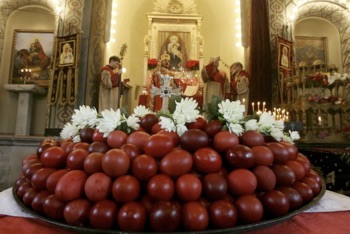
And these red Easter eggs appear to be ubiquitous among the Eastern Orthodox faithful throughout Eastern Europe (and the Eastern-rite Catholics as well). Why?
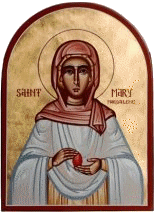
Most modern icons of Mary Magdalene, like the one on the left, show her holding a red egg. From antiquity, red has always been a color associated with Mary Magdalene in both the Eastern and Western churches. In the West, she is often shown with red hair and/or a red dress. In the East she is more often shown with a red veil and associated with the red Easter eggs.
And there exists a tradition which makes Mary Magdalene the originator of the custom of making red eggs at Easter. According to a 10th century Greek legend (via Voropay), after the Savior had ascended into heaven, Mary Magdalene came to Rome to preach the Gospels there. In Rome she stood before the emperor Tiberius and raised up a red egg, saying: “Christ is risen!” Thus she began her preaching.2.
It is said that, after learning about this offering of Mary Magdalene, the early Christians began to imitate her, presenting each other with red eggs at Easter. Eggs were thus said to have been used by Christians since the earliest centuries as a symbol of the Resurrection of Christ, and of the regeneration of Christians for a new and a better life along with it.
However, as Voropay notes, many ancient cultures dyed eggs, and this may be just another example of religious syncretism: adaptation and absorption by one religion of the customs and traditions of another. The Persians were known to dye eggs for their Zoroastrian New Year’s celebration, Nowrooz, and still do. Their New Year’s celebration falls at the beginning of spring, around the time of the vernal equinox, as it did in most of Europe in earlier times.
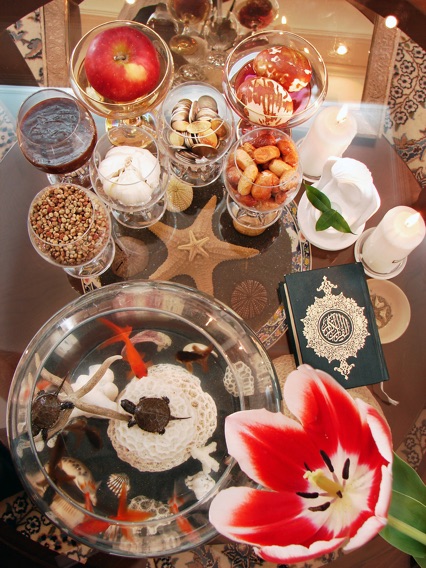
Nowrooz Haft Sîn (Hamed Saber)
Krashanky were place into the family’s Easter basket, and blessed at the church. During the Great Lent, eggs were not eaten, so they were quite a treat on Easter itself.
Children would play various games with the eggs, including having krashanka battles: one would hold an egg still in his hand, while the other would hit it straight on, pointed end to pointed end. The egg that cracked would lose the battle, and the winner would take it as a prize.
Krashanky, like pysanky, had talismanic powers. Voropay discusses the traditions at length in his book. The krashanky themselves, particularly those that had been blessed, were holy and could not be trampled upon–to do so would bring bad luck. Girls would wash themselves in water in which a blessed krashanka had been placed to make themselves more beautiful2. And the shells of a krashanka could not simply be thrown out: they were fed to the chickens to help them lay3, saved to smoke out fevers4, or tossed in a river to send them to the Rakhmany5, so as to let them know Easter had arrived in the land.
Dying Red Easter Eggs
Red eggs are quite easy to prepare. All you really need are eggs, yellow onion skins and vinegar. It may sound counterintuitive, but the skins of yellow onions work wonderfully and produce a lovely red hue. My mother makes them every year, and I make sure to have at least one in my basket for blessing.
Most people make them by simply boiling eggs with onion skins and a few tablespoons of vinegar. Some will also rub a bit of cooking oil or animal fat onto the shell to make it shine. The following more complex instructions were taken from About.com, proving that there is no procedure so simple that someone can’t make it more complicated.
(For different colors of krashanky, check out the recipes from Martha Stewart here.)
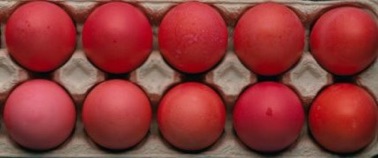
How to Dye Red Easter Eggs with Onion Skins
Time Required: 50 minutes + 2 hours cooling
What You Need:
•Fresh uncooked eggs at room temperature
•Skins from yellow (Spanish) onions
•White vinegar
•Saucepan
•Strainer
•Bowl
•Slotted spoon
•Paper towels
•Cooling racks
•Olive (or other edible) oil for polishing
Here's How:
1.Start with 12 medium-to-small eggs.
2.Carefully remove any material clinging to the surface of the eggs.
3.Make the dye with the onion skins: In a stainless saucepan, place skins of 15 yellow (Spanish) onions and 2 tablespoons of white vinegar in 4 1/2 cups of water and bring to a boil. Lower heat and simmer, covered, for 30 minutes.
4.Strain dye into a glass bowl, and let cool to room temperature. (Don't be fooled by the orange color.)
5.In a stainless saucepan (around 8 1/4 inches in diameter), add the cooled strained dye and eggs at room temperature (up to 1 dozen). The eggs should be in one layer and covered by the dye.
6.Bring to a boil over medium heat. When boiling, reduce heat to low, cover, and simmer.
7.Dyeing time will be affected by the color of the eggs. Start checking for color at 12-15 minutes. Do not simmer longer than 20 minutes (see step 9 if they aren't red enough).
8.When eggs are the right color, proceed to step 10.
9.If eggs are not a red enough color after 20 minutes, leave in the pot and remove from heat. When the pot as cooled enough, place in refrigerator and let sit until desired color is reached.
10.Remove eggs with a slotted spoon and cool on racks.
11.When they can be handled, coat lightly with olive (or other edible) oil and polish with paper toweling.
12.Refrigerate until time to use.
Tips:
1.Save onion skins in a plastic bag in the refrigerator until ready to use.
2.Do not use any porous (wood, ceramic, plastic, etc.) materials as they can be colored by the dye.
3.If stainless cookware and utensils get colored by the dye, wash with regular detergent and a small amount of chlorine. Rinse very well.
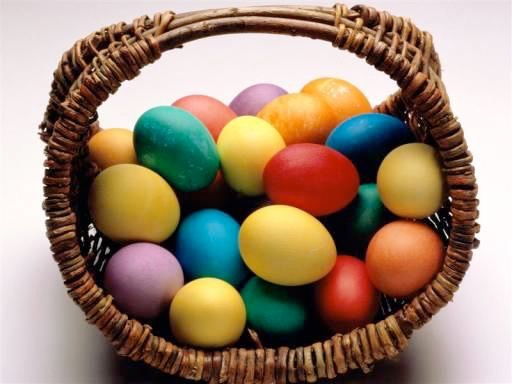
Modern day krashanky
___________
1.The nineteenth-century ethnographer O. Tereshchenko left this description of the Velykden feast: “In Ukraine, people celebrate Velykden in a merrier and richer fashion than they do in the in Russia. Pasky are lined up on the table with a willow twig stuck into each one and a wax candle fixed on top; there are bowls filled with Easter eggs painted yellow, blue, and red; a roasted pig sits in the centre of the table with a horseradish in its mouth; vegetables and parsley and other green things are placed on both sides of it as well as roasted geese, turkey, ham, sausage, lard, black bread, sweetmeats, cheese, a carafe of horilka (vodka), nastoyanky and nalyvky (alcoholic drinks made at home from fruit and berries). The table is so laden with food it sags in the middle; the celebrations may continue for several days.”
2.At home, after the blessing of the basket, the hostess of the house would put a krashanka into a basin filled with water and the children would wash their faces with this water “to be healthy and strong.” Girls, who washed their faces with this water, hoped it would help them to be beautiful. Performing this ablution, the girl might say, “I wish I were as krasna (beautiful) as this krashanka.
3.Krashanka shells were used throughout the homestead to help ensure fertility of both plant and livestock. In some regions of Ukraine, they were buried in the grain fields for the grain to grow well; they were buried in vegetable gardens at such places where they would not be trodden on, to chase away pests and for vegetables to grow thick.
4.The krashanka shells might also be pounded in mortars and then given to the sick to help them to become well again.
5.Rakhmaniya is said to be “a dream land beyond the sea where time stands still,” but there is little agreement on who the Rakhmany actually are. There is no generally accepted explanation of the origin of the belief in Rakhmany or of the origin of the word itself, but they evidently symbolize self-sacrifice for the benefit of others.
The Ukrainian ethnographer V. Shukhevych wrote, “The Hutsuls believe that Rakhmany live like monks somewhere in the east, they pray for us and thanks to them, we can live in this world because they take upon themselves all our sins; they are fasting all the year round, and only on Velykden they eat a piece of an Easter egg which is shared among twelve of them.”
Other Hutsuls believed that krashanka shells were carried by the currents across the sea to Turkey where they reminded Christians, who toiled there in captivity, that Velykden (Easter) has come.
Note: The additional material in these footnotes is taken largely from the “Welcome to Ukraine” website; the name of the author is not given. I’ve included this material because it is based on sources besides Voropay.
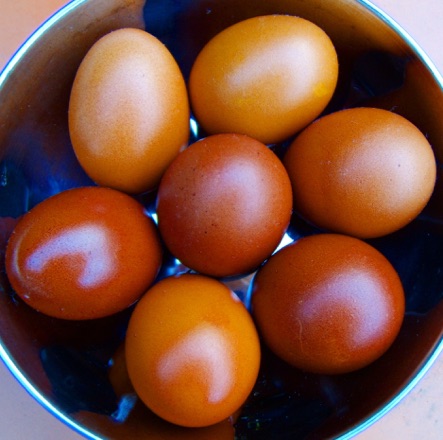
Back to MAIN Pysanka home page.
Back to Main Types home page.
Back to Pysanka Index.